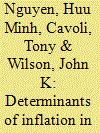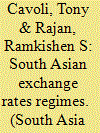| Srl | Item |
| 1 |
ID:
106403


|
|
|
|
|
| Publication |
2011.
|
| Summary/Abstract |
Recent literature suggests the extent of foreign listings (cross-listings) on domestic stock exchanges may be informative as a measure of financial integration. In this study, we present both stylized facts and panel data analysis examining relationships between the proportion of foreign listings and other measures of integration in a sample of Asian markets to determine if this form of cross-listing complements or substitutes for other aspects of integration. We find that higher trade openness, higher output growth and lower inflation are associated with a greater proportion of foreign listings. In addition, we find that FDI openness has a negative relationship to the proportion of foreign listings, suggesting that these aspects of financial integration are substitutes. For policymakers, our results indicate that unless the appropriate financial liberalisation policies are in place, countries may find it difficult to simultaneously attract foreign listings to enhance development of their stock market and to grow their real economy through FDI.
|
|
|
|
|
|
|
|
|
|
|
|
|
|
|
|
| 2 |
ID:
111868


|
|
|
|
|
| Publication |
2012.
|
| Summary/Abstract |
This paper employs a simple macroeconomic model of inflation to empirically investigate the determinants of CPI inflation for Vietnam over the period 2001 to 2009. Vietnam is chosen as our focus for this study because of the country's recent history of high inflation since the end of the Vietnam War in 1975 and the Adjustment of Price reforms in 1985. We are particularly interested in examining the role of the exchange rate in explaining inflation, and of the effect of supply side factors such as the prices of crude oil and rice. Using a range of time series estimation techniques, we find that inflation is persistent and that the money supply, oil prices and rice prices present the strongest influences on CPI inflation.
|
|
|
|
|
|
|
|
|
|
|
|
|
|
|
|
| 3 |
ID:
078277


|
|
|
|
|
| Publication |
2007.
|
| Summary/Abstract |
This paper presents an empirical investigation on an important policy issue, namely, whether there is any evidence supporting monetary integration between the Chinese mainland and Hong Kong. We follow two lines of inquiry. First, we present a series of simple tests to find the extent to which trade and/or financial linkages exist between the two regions. Second, we use simple inflation and output differentials and structural VAR techniques to test for the degree of business cycle synchronization between the two regions. The results indicate that there is evidence supporting the existence of trade linkages and that there is also support for the possible synchronization of business cycles. We discuss the implications of this for monetary integration between Hong Kong and the mainland.
|
|
|
|
|
|
|
|
|
|
|
|
|
|
|
|
| 4 |
ID:
103952


|
|
|
| 5 |
ID:
121189


|
|
|
|
|
| Publication |
2013.
|
| Summary/Abstract |
This article presents an analysis of the degree of de facto exchange rate flexibility in the exchange rate regimes for selected South Asian economies, viz., Bangladesh, India, Pakistan and Sri Lanka. Three commonly employed measures of exchange rate classification are used: a simple exchange market pressure (EMP) measure, a GARCH specification and a regression-based model. The article finds strong evidence of limited flexibility in all the South Asian economies-particularly against the US dollar, which can suggest a heavy degree of currency management. While Bangladesh, Pakistan and Sri Lanka effectively have fixed exchange rate regimes vis-à-vis the US dollar, India appears to operate somewhat more as a managed floater with a movement towards greater flexibility in recent years.
|
|
|
|
|
|
|
|
|
|
|
|
|
|
|
|